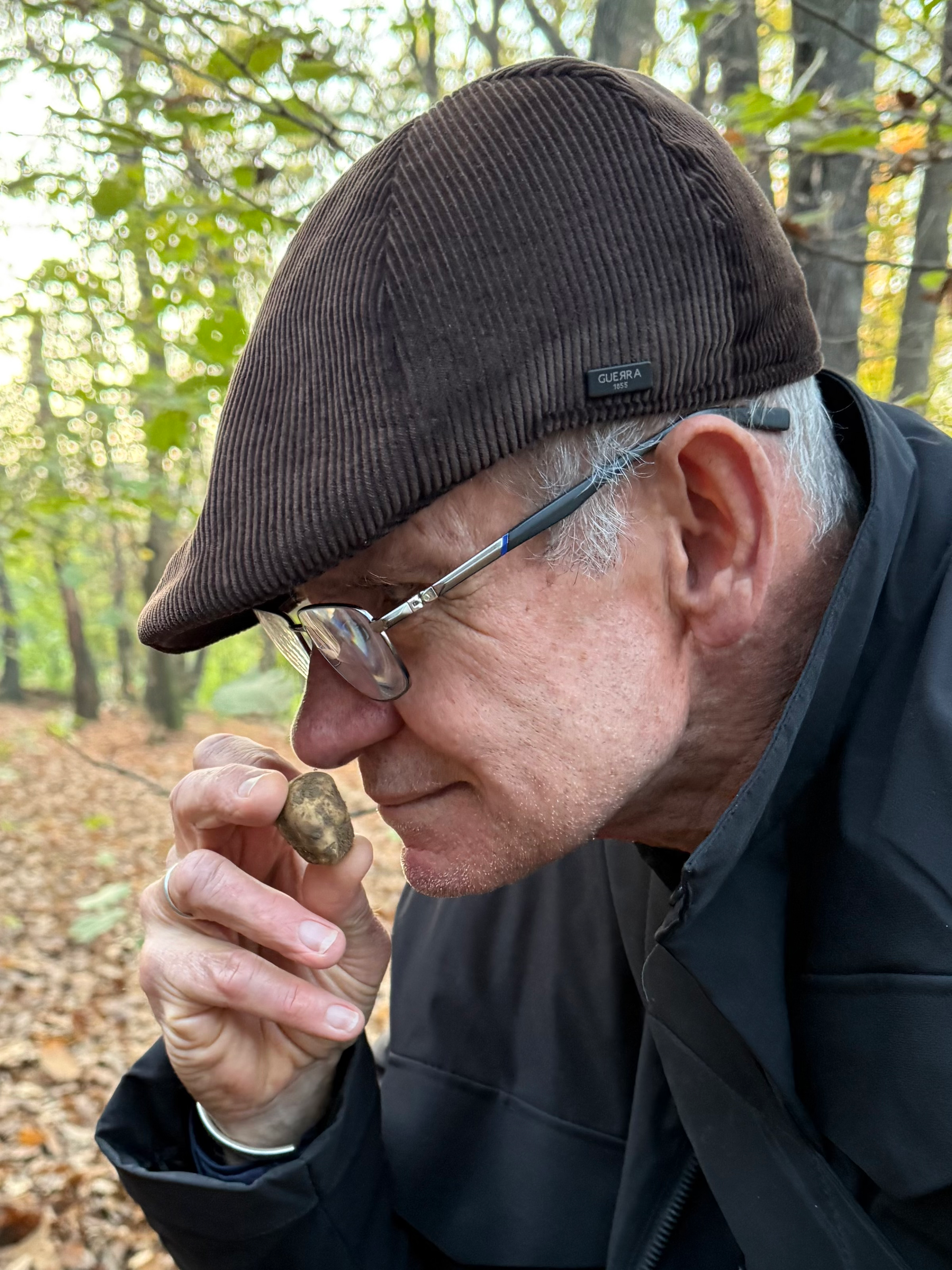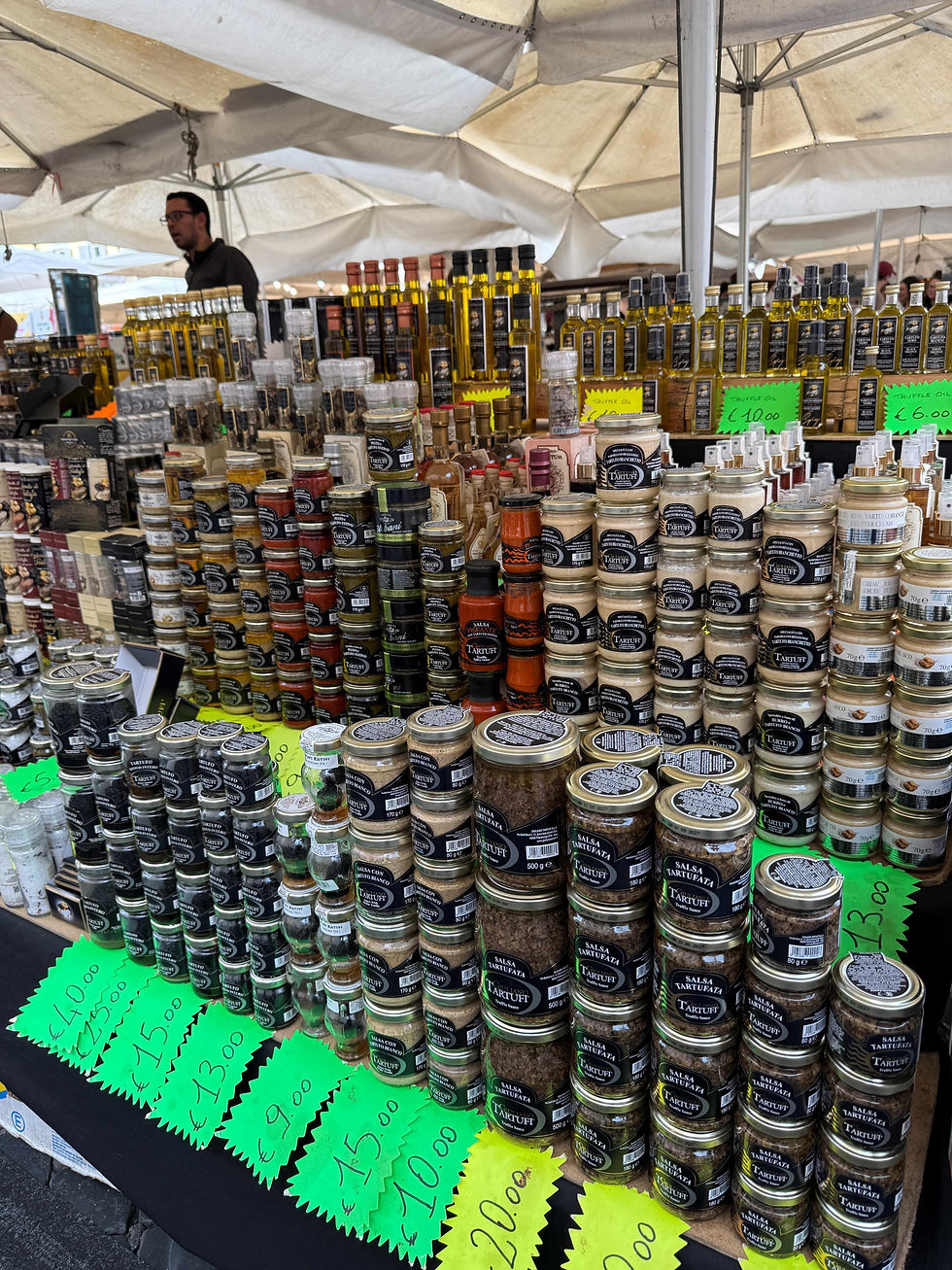The three things we learned from Italian truffle culture.
- Carmine Di Campli

- Jul 24
- 5 min read
Updated: Aug 8
This week, we’re reflecting on the unforgettable lessons we learned from our truffle tour of Italy last year. While a step-by-step breakdown of the truffle experience is still to come in a future post, today, we’re taking a brief detour from the science of gastrophysics. Instead, let’s dive into the rich journey of exploring one of the world’s most sought-after travel destinations: Italy’s truffle regions.
For Leesa and me, it was a deeply immersive experience. We didn’t just observe, we lived it. From the picturesque hills of Toscana to the rolling landscapes of Piemonte and the rugged beauty of Abruzzo, we embraced it all (well, almost). It was everything we had hoped for yet not without its surprises. We found the passion for local provenance palpable, but also the contradictions. On one hand, people were fiercely protective of their local truffles; on the other, we were struck by the proliferation of artificially flavored truffle products. In some restaurants, typically the up market ones, the truffles were proudly sourced from nearby forests; in others, particularly those catering to tourists, truffle oil was liberally drizzled on just about everything.
For us, Italy unfolded as a tale of two worlds: the tourist experience and the slower, behind-the-scenes one. The latter left the deepest impression. It was in those moments—meeting a passionate chef or visiting a truffle hunter’s home, hearing stories of their dogs and their truffle-finding skills—that we truly felt the essence of Italy. But before I get ahead of myself, let’s start with one of the most important lessons we took away: provenance.
Provenance, Provenance, Provenance
Much like real estate, where it’s all about “location, location, location,” in Italy, when it comes to anything culinary, it’s all about Provenance, Provenance, Provenance.

One experience that really emphasized this was when my cousin took us to the hilltop town of Castel Del Monte,
on the edge of the rugged Abruzzo National Park. But before I get too carried away, here’s a little-known tidbit about Italian food culture: in Italy, mortadella is often seen as a second-class cut of meat, somewhat like how Devon is viewed here in Australia. It’s used in everyday dishes but rarely gets any spotlight on a trattoria's menu. That is, unless you’re at a place like this one. Here, the owner crafted traditional mortadella from scratch, using his own livestock which he butchered and cured in his own cellars . And the kicker? The livestock was donkey. Yes, donkey. That's traditional mortadella.
Another fascinating tidbit we learned: some chefs won’t attempt traditional dishes unless they’re from the region where that dish originated. It’s a level of authenticity that Italians truly appreciate, and yes, they’ll happily travel across the country to experience it. The same respect for tradition applies to truffles.
During our truffle experiences, each server could tell us exactly where the truffle had been foraged, whether it was from a forest or near a particular town—and even how old it was and how it would perform on the plate.

Our arrival in Toscana coincided with the beginning of truffle season, and I couldn’t wait to try my first white truffle (Tuber magnatum pico) from the famous town of San Miniato. The server, however, gently advised that the aroma was still developing. I was eager, but he was right. When the dish arrived, a simple pasta with a butter emulsion then freshly grated truffle at the table, it didn’t quite live up to my expectations.
I learned an important lesson that day: patience and respect for the ingredient. It was just the first of many truffle experiences to come, and each one would be better than the last.
Seasonal Ingredients, Prepared Simply
If there’s one thing you learn in Italy, it’s that the beauty of the food lies in the quality of the ingredients and the simplicity of preparation. This is particularly true when it comes to truffles.

Truffles are, after all, the royalty of the culinary world. They’re rare, expensive, and should always be served with a sense of occasion. So, it’s puzzling to me when some restaurants here in Australia pair truffles with overly complicated, flavor-packed dishes, expecting the truffle to shine. Sometimes, you can’t help but feel that the star of the dish isn’t the ingredient, but attempts to be the chef’s technique, or lack thereof.
In contrast, every truffle experience we had in Italy (except for one) was refreshingly simple, pasta with a butter emulsion. Nothing more. Nothing less. And they were glorious. The simplicity allowed the $7,000-per-kilo truffle to take center stage, highlighting its unique local aroma and luxurious flavor.
The one exception? A saffron risotto in Alba. But once again, simple and glorious.
The Problem with Artificial Truffle Oil and Products
If Italy is the heart of the truffle world, it’s also the cradle of artificial truffle products. From the toe to the top of the boot, there are entire shops and market stalls selling truffle-flavored products, none of which actually contain any real truffle. They all have the same look, the same price tag, and unfortunately, the same synthetic flavor.

I struggle to understand this contradiction. In the land that champions provenance, here’s a product that tastes the same no matter where you buy it. No regional distinction, no uniqueness, no seasonality, just a chemical flavor that could have been made anywhere.
In Alba, the heart of white truffle country, I asked one of the truffle judges why, at an international truffle fair dedicated to the "queen of truffles," more than half of the stalls were dedicated to artificial truffle products. His answer? A shrug and a weary, Non so (I don’t know). But something in his eyes told me he understood exactly why. It wasn’t a romantic explanation, it was a cold, hard commercial reality. If these artificial products weren’t there, many stalls would be empty. A bit of a downer to end on, I admit. But that's the reality.
Final Thoughts
So there you have it—a few of the lessons we picked up from our truffle journey in Italy. If you enjoyed this post, why not share it with your friends?
We’d also love to hear from you in the comments below. Have you had any memorable truffle experiences while traveling? What stood out to you the most? Let us know!
For now, Ciao! I look forward to welcoming you back next week when I’ll explore the nutritional benefits of truffles. Until then!
Carmine






Comments